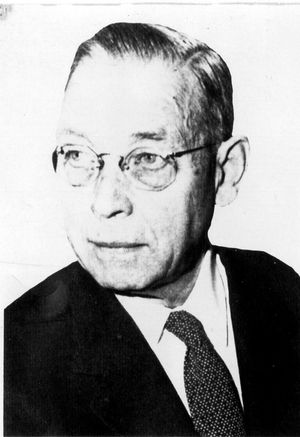John B. Johnson
- Birthdate
- 1887/10/02
- Birthplace
- Gothenburg, Sweden
- Associated organizations
- Bell Labs
- Fields of study
- Communications, Electronics
- Awards
- IEEE David Sarnoff Award
Biography
Dr. John Bertrand Johnson was born in Gothenburg, Sweden on October 2, 1887. As so many Scandinavians have done, at 17 he migrated to Velva, N.D., where he had relatives. He enrolled as a freshman at the University of North Dakota in 1910, receiving the degree of B.Sc. in 1913 and the Master's degree in 1914. After completing 3 years of graduate work in Physics at Yale University and receiving the Ph.D. degree, Dr. Johnson joined the Western Electric Engineering Department at 463 West Street, New York City, which, in 1925, became Bell Telephone Laboratories.
His entire career, from 1917 to his first retirement in 1952, was in the study of fundamental problems in the application of electronics to telephony, radio, and television. As early as 1922 he made the cathode ray oscillograph a common laboratory tool. During the 1920's also, he studied the sources of "noise" in electrical circuits and made fundamental contributions in this field. The "thermal noise" in circuits, which has been predicted by Schottky in Germany a number of years before, was shown by Dr. Johnson to exist and to set an ultimate limit to which amplifiers can be pressed. This is often called "Johnson noise".
During World War II, Dr. Johnson was engaged in solving problems in supersonics and in thermionics, and he developed a new and special type of oscillograph tube. He discovered a type of thermionic electron emission following electron bombardment, and he developed a method of measuring the secondary electron emission from insulators that has been much used since then.
Upon retirement from Bell Telephone Laboratories in 1952, Dr. Johnson joined the Thomas A. Edison Central Research Laboratory as head of the Physics Department. In 1959 he moved to the Instrument Division as a Research Engineer and Consultant on Electron Physics.
Under his direction was developed the U-V Detector Tube, which contributed in a major way towards the solution of certain fundamental problems related to solar blind ultraviolet sensors and to their application to both aircraft and ground-based fire detectors, to fire-out warning systems, to fog detection and visibility measurements and other uses. He was also active in advancing the art in the area of prime movers for high-pressure transducers and in the development of light-scattering instruments operating in the mid-ultraviolet region.
Dr. Johnson is a Fellow of the IEEE, of the American Physical Society, and of the American Association for the Advancement of Science, and a past Chairman of the APS Division of Electron Physics. He is a member of Phi Beta Kappa, Sigma Xi and Gamma Alpha. He has taken an active part in community affairs, being President of the local Civic Association in 1937 and 1938; Section Chairman, Library Drive 1946; Board of Local Improvement Assessment Commissioners in Millburn, N.J., 1950-1969 (Chairman 1966-1969); and Boy Scouts Troop Committeeman (Chairman 1940-1945). After more than 50 years in electronics, and now in his 83rd year, Dr. Johnson finally decided to retire completely in 1969.
He has published more than 20 important papers in electronics, and has been granted about 30 patents, predominantly in the communications field. In recognition of his work Dr. Johnson has been awarded the Longstreth Medal (1957) by the franklin Institute; and the Edwin H. Armstrong medal (1967) by the Radio Club of America.
Dr. Johnson was married in 1919 to Clara L. Conger who died in early 1961. He had two sons, and five grandchildren. In late 1961 Dr. Johnson married Ruth M. Sivertssen Bowen formerly of Velva, N.D. They resided in Short Hills, N. J. His hobbies were gardening, opera, lapidary work, and domestic handywork.
